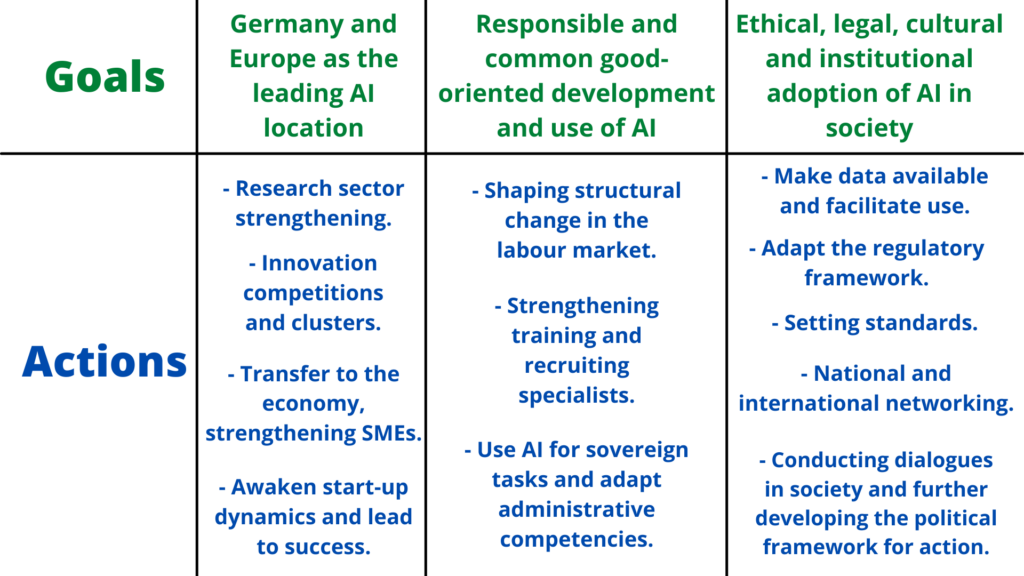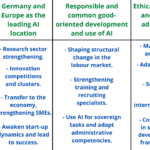“A famous quote in my country is that Germany lost the first halftime of the digital transformation. The Federal Government is anxious to win the second half with initiatives like Industrie 4.0.” This was how one man described the motive behind drafting Germany’s Artificial Intelligence (AI) Strategy, known as “Strategie Künstliche Intelligenz der Bundesregierung“. Let’s take a brief look at Germany’s AI catchup strategy and how far it has come.
Germany’s AI Catchup Strategy
The German government’s AI catchup strategy is a framework for developing and applying AI solutions in Germany as part of the country’s digitalisation. Or as German Chancellor Angela Merkel was quoted saying: “To make Germany a leading international location for AI.”
“Once a tech front-runner, Germany now faces the mammoth task of catching up with today’s AI giants. Angela Merkel has launched a broad initiative to transform lagging digital infrastructure and paper-based bureaucracy.”
How DW described the AI strategy.
The AI catchup strategy was created following a Germany-wide online consultation process jointly led by the Federal Ministry of Education and Research, the Federal Ministry for Economic Affairs and Energy, and the Federal Ministry of Labour and Social Affairs.
The document indicated that the German government decided to seize the opportunity to leverage AI for the greater good based on deduction systems, knowledge-based systems, pattern recognition, robotics and human-machine interactions, while taking into consideration the pros and cons of AI.
Hence, the German government has several goals to achieve with its AI strategy. The 3 goals and some of the actions needed to make this plan a reality are listed as follows:

Here are the steps of the more detailed action plan (directly translated from German to English) for your reference (but no hard feelings if you skip to the next section):
“1. Research sector strengthening
- We will continue to develop the existing AI competence centers nationwide and expand them with further centers to be set up to form a national network of at least twelve centers and application hubs. In doing so, we will enable internationally attractive and competitive working conditions and remuneration.
- We will establish regional competence centers for work research in order to better interlink work research in the age of AI with work design in operational practice. The responsible federal ministries will coordinate their transfer structures and develop a joint AI transfer concept.
- We will develop cooperative structures within the framework of a national research consortium and work more closely with external stakeholders.
- We will set up a program for the promotion of young scientists and teaching in the field of AI. With at least 100 additional new professorships, we want to ensure that AI is broadly anchored at universities.
- Together with France, we will promote the development of a German-French research and innovation network (“virtual center”) on the basis of the existing structures and competencies of both countries.
- We will support the connection of software and hardware development in terms of a system approach.
- We will promote research on procedures for the control and traceability of algorithmic forecasting and decision-making systems
- We will promote the research and development of applications to protect consumers and privacy in order to enable differentiated and self-determined handling of personal data.
- We want to leverage the potential that lies in the connection between AI and key technologies, such as biotechnology and production technologies.
- We will use the possibilities of AI in agriculture and in the food chain.
- As a contribution to civil security, we will intensify research and development of AI-based technologies.
- We will increase the attack security of AI systems and further expand AI as the basis for general IT security.
- We will use the possibilities of AI in the health sector and support the data protection-compliant development of the data generated in distributed data sources, taking into account the interests of patients worthy of protection.
- We will expand research and development of AI in the care sector.
- The federal government will intensify research and development of space technologies in combination with AI.
- The Federal Government will incorporate regulatory expertise at an early stage in research and development activities that have to meet particularly stringent regulatory requirements in order to be successfully implemented.
- The Federal Government will review existing funding procedures for their applicability to research on AI and initiate the development of faster or newer funding formats.
2. Innovation competitions and clusters
- We will make AI one of the focal points in the planned agency for leap innovations.
- We will form a European innovation cluster on AI in which research cooperation projects will be funded over the next five years.
- In the area of AI, the federal government is examining an “important project of common European interest”.
3. Transfer to the economy, strengthening SMEs
- The Federal Government will strengthen and expand the existing transfer structures.
- The Federal Government will continue to develop funding measures and establish additional networking formats.
- We will expand the AI-specific support for medium-sized companies. Via the competence centers for medium-sized companies 4.0, we will achieve at least 1,000 company contacts annually through “AI trainers”.
- The federal government wants to support the establishment of test fields.
- The federal government will initiate, support and accompany the construction of real laboratories.
- We will promote lighthouse projects and make them known.
- We will put together interesting AI examples on a map.
- The federal government will support cooperation between companies.
- With an AI monitoring we will determine the penetration of AI.
4. Awaken start-up dynamics and lead to success
- The budget for EXIST, a start-up program, will be doubled in 2019 compared to previous years.
- We are expanding public funding opportunities in the area of venture capital and venture debt and are taking a Tech Growth Fund initiative in particular.
- We are continuing to expand offers for comprehensive advice and support for start-ups.
- With the digital hub initiative, we will strengthen the AI competence of start-ups.

Image Source: Mika Baumeister
5. Shaping structural change in the labour market
- The federal government will set up a German observatory for artificial intelligence and work to set up such observatories on a European and international level.
- The Federal Government examines the auditing of AI in an operational context.
- The Federal Government is organizing a European and transatlantic dialogue on the human-centered use of AI in the world of work.
- As part of a national further training strategy, the federal government will develop a broad range of instruments to promote the skills of employed people.
- On the analytical basis of a new skilled worker monitoring system, the Federal Government will further develop the skilled workers strategy, also with a view to digital change and new technologies such as AI.
- The federal government will secure the company co-determination options when introducing AI applications and examine whether more legal certainty can be created when introducing such applications in the company within the framework of an independent Employee Data Protection Act.
- The Federal Government supports the transfer of knowledge about the human-centered use of AI in the world of work through a funding guideline for company experimentation rooms that test AI applications.
- We will set up regional future centers in East Germany and test them as models.
6. Strengthening training and recruiting specialists
- Expansion of the early promotion of understanding among young people for AI through opportunities to “understand” and participate.
- Promotion of basic, advanced and advanced training programs, taking into account the specific characteristics of individual areas, such as the health system or the food supply chain.
- Integrate basic AI knowledge as an integral part of teaching content in vocational education and training where it makes sense.
7. Use AI for sovereign tasks and adapt administrative competencies
- The Federal Government wants to take on a pioneering role in the continued use of AI in administration and thus contribute to improving the efficiency, quality and security of administrative services.
- The provision of open administrative data for unrestricted further use is to be expanded in the future.
- The federal government wants to identify suitable subject areas for the security authorities and promote AI in terms of agile, practical development.
8. Make data available and facilitate use
- We will examine the need for a data and analysis infrastructure and the necessary public-private willingness to cooperate.
- We will support the European Commission closely in the implementation and updating of the initiative to build the European Data Area.
- We want to set incentives and framework conditions that facilitate the voluntary, data protection-compliant sharing of data.
- We will examine the formation of “data partnerships” between companies and with research institutions.
- We develop criteria for a design of “data partnerships” in accordance with antitrust law.
- We will examine whether data sets from publicly funded research projects can also be used by third parties while safeguarding protective interests in this data.
- We want to systematically promote the accessibility of earth observation data with high-performance infrastructures in order to be able to analyze and evaluate them comprehensively with AI methods.
- We will examine the targeted promotion of open, data protection-compliant training data sets.
- At European level, we will encourage targeted research and development on anonymization, the use of synthetic data and “small data”, and we will also examine funding options at national level.
- We will also examine the need for additional funding for data management in the authorities at the federal level.
- We will convene a round table with data protection supervisory authorities and trade associations in order to jointly develop guidelines for the development and use of AI systems in compliance with data protection law and to prepare examples of best practice.
- We will strengthen and expand research on the exchange and interoperability of industrial data.
- We will promote the development of standards for data formats and interfaces and initiate cooperation at European level.
- We will specifically promote the usability of AI systems in the health sector.
9. Adapt the regulatory framework
- The federal government will review the legal framework for the use of data for the application of AI technology.
- The Federal Government will examine how transparency, traceability and verifiability of the AI systems can be created in order to enable effective protection against distortions, discrimination, manipulation or other improper use, especially when using algorithm-based forecasting and decision-making systems.
- The Federal Government promotes the development of innovative applications that support self-determination, social and cultural participation and the protection of the privacy of citizens.
- The federal government will adapt the copyright legal framework in order to facilitate text and data mining (TDM) as the basis for machine learning for both commercial and non-commercial purposes. The interests of the rights holder and the user involved are brought to a fair balance.
10. Setting standards
- The Federal Government is looking into supporting the participation of experts, especially SMEs and start-ups, in international standardization processes.
- The Federal Government supports the standardization of terms and classifications of AI (e.g. dimensions of independence, independence of learning, risks associated with AI).
- In a joint project with DIN, the federal government will develop a roadmap for norms and standards in the field of AI.
- The federal government is taking an initiative together with business, science and standardization organizations to represent European interests more closely in international standardization bodies.
11. National and international networking
- Coordination of the measures of the AI strategy with other activities of the federal government.
- Greater cooperation with the EU institutions, in particular with the European Commission and other member states, on issues relating to the framework conditions for the use of AI in the common digital single market and in the context of implementing the European AI strategy.
- Exchange and, if possible, understanding about common guidelines with internationally leading regions and economic areas.
- Building capacities and knowledge on AI in developing countries as part of economic cooperation so that economic, societal and social opportunities can be used there.
12. Conducting dialogues in society and further developing the political framework for action
- With a “Future Fund for Digital Work and Society”, the federal government will promote education and multidisciplinary social technology design on a broad basis.
- The federal government will develop the platform for learning systems into a platform for artificial intelligence, in which an exchange between politics, science and economy with civil society is organized.
- The Federal Government will support social partnership dialogues for the sustainable integration of AI in the world of work.
- The federal government will set up a communication strategy on AI.”
Naysayers about the AI catchup strategy
There seems to be another inside joke among the German speakers that the German government does not usually have a clear message and that the AI catchup strategy is reflective of the Bundesregierung’s lack of clear messaging.
While someone might feel overwhelmed reading Germany’s document, someone wrote on The Asia Dialogue that the approaches in Germany’s AI strategy were not as clearly defined as China’s equivalent of the AI strategy due to the lack of specificity and measurability (although he was fair enough to acknowledge the good side of Germany’s plan).
“… these initiatives mean little if the German government does not have a good sense of what AI is. ‘You also have to think about what a student or PhD researcher trained in AI actually is? Which fields count? … If you want to measure it, you need to start to count it. And for that you need to more clearly define which sorts of approaches are within it’, says [Stefan] Heumann…
China’s plan, however, is different. It outlines a long list of specific technologies which the government wants. Matt Sheehan, a non-resident Fellow at the Paulson Institute, calls it the ‘wish list’ approach. The list includes things such as smart orchards, household items with enhanced sensing and connectivity, and intelligent parcel sorting…”
Plucked from The Asia Dialogue article.
This opinion was among the doubts that the plan was met with, implying that the plan was a case of being easier said than done.
It was also suggested that there might be some political obstacles along the way. For example, the German Laender calls the shots in education and skilling, so if the German government wants to hire 100 AI professionals, the Laender will have to give the green light.
There’s also a lack of consideration for military and security applications since the German plan is focused on civil applications, which probably reflects the German culture of dodging military discussions. Another aspect of the German culture that’s getting in the way of the strategy is the skepticism about data protection in AI.
And, of course, there’s the question of the AI strategy budget and where all the money is coming from since it’s been said in the German AI strategy that the government would allocate €500 million to strengthen the AI strategy from 2019 onwards and another €3 billion to implement it until 2025.
Progress of the AI catchup strategy so far
On the bright side, the first review of the AI catchup strategy published a year later has shown that some progress was made. In fact, so many achievements have been accomplished that it’s difficult to list all of them here. Contrary to the doubts mentioned above, it looks like implementing the strategy is possible after all.
To check the full review, just go to Ingo Hoffman’s blog post and click on the hyperlinked word “link here” to download and access the review document. Since it’s in German, you can upload the document to Google Translate to translate it to English (or whatever language you prefer reading in).
While we’re still here, let’s end this article on a happier note by looking at a few notable achievements:
- The number of AI start-ups rose by 62% in one year. In June 2019, a total of 214 AI start-ups that met the specific qualitative criteria were counted. The front runner is Berlin with 86 AI start-ups, followed by Munich with 57.
- As of February 2019, 192 existing professorships, 22 planned professorships and 75 existing courses related to AI in German universities were recorded.
- 15 new funding measures have been implemented in both basic research and various application areas such as autonomous driving, microelectronics, IT security and production technology.
- 33 AI trainers have started work at selected competence centres.
- Further development of AI-assisted weather forecast models for the German Weather Service.
- Expansion of the mCLOUD as an open data portal for the mobility sector.
- The data ethics committee gave its opinion in 2019 regarding the regulatory framework.
- The AI standardisation roadmap was developed to set the standards in the field of AI.
And if this article has left you feeling tense, here’s something to turn your frown upside down. When I tried searching for royalty-free pictures on Unsplash using the term “german artificial intelligence strategy“, the search results looked like this:
FAQ
What is Germany's AI catchup strategy?

Germany’s AI catchup strategy is a framework for developing and applying AI solutions in Germany as part of the country’s digitalisation.
What are the goals of Germany's AI catchup strategy?
What kind of actions are expected from Germany's AI catchup strategy?

1. Research sector strengthening.
2. Innovation competitions and clusters.
3. Transfer to the economy, strengthening SMEs.
4. Awaken start-up dynamics and lead to success.
5. Shaping structural change in the labour market.
6. Strengthening training and recruiting specialists.
7. Use AI for sovereign tasks and adapt administrative competencies.
8. Make data available and facilitate use.
9. Adapt the regulatory framework.
10. Setting standards.
11. National and international networking.
12. Conducting dialogues in society and further developing the political framework for action.



